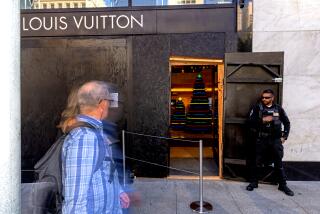Home Invasion Changes Seen
- Share via
With images of bound and beaten victims and tormentors holding guns to heads to find cash and jewelry, the mere thought of a home-invasion robbery can terrify even the most secure suburbanite.
Worse still, Orange County saw a rash of the crimes in the last several months, with five robberies in Fullerton within a few weeks in August and other attacks in Santa Ana, Fountain Valley, Garden Grove and Yorba Linda.
But such a flare-up stands out these days because it has become the exception. The brutal robberies have been in decline during the last few years, according to figures from the state and federal departments of justice.
While the numbers are dropping, those who commit the crimes are changing. Investigators say home invasions--once the trademark of Asian gangs that preyed mainly on recent Asian immigrants--are being committed increasingly by criminals of all ethnicities.
As is often the case, jail is the university where details of the crime are taught. There, other criminals have learned from Asian gang members how successful home invasions have been, said Westminster Police Det. Rick Vincent.
At the same time, many Asian gang members have moved on to less risky but more profitable crimes, such as computer-chip theft, forgery and credit-card fraud, police say.
Such crimes are harder to investigate and prosecute, Garden Grove Police Det. Dave Johnson said, and criminals know they might get 18 months in prison for a forgery conviction as opposed to eight years for a violent robbery.
Because home invasions are lumped with other robberies, the crimes are hard to track. But the numbers of robberies committed at residences have been dropping since 1991 in California and since 1993 in the United States.
In the early 1990s, for example, Garden Grove police reported more than 70 home invasions a year. This year, the city has seen only about 14, Johnson said.
Westminster, like Garden Grove, a city with a large Asian population, has had only one home invasion this year, Vincent said. At the peak of the crime’s popularity, it could have expected about 20.
Detectives said prevention is also helping as residents realize the danger of keeping valuables and large amounts of money at home. Many are also living more modestly, so as not to flaunt their wealth.
Investigators also credit the decrease to the new-found willingness of recent immigrants to report the crimes. The push by many departments to hire Asian officers is counteracting the mistrust of police that many immigrants have brought with them.
*
But as potential victims become more savvy, so do the criminals.
When Asian gangs preyed on recent Asian immigrants, they used to simply knock on doors and wait for unwitting residents to let them in.
Now, most home invaders break in through unlocked doors or windows and wear surgical gloves and masks to hide their identities.
A gang of home invaders busted last year posed as police officers to get inside houses. They’re suspected in 90 home invasions in Orange and Los Angeles counties.
In San Jose, a city with a large Asian immigrant population that also had its share of home invasions, Police Sgt. Bob Beams said his department relies on immigrants established in the community to warn newcomers about the attacks and to vouch for the credibility of the police.
“We had to do a lot of outreach to the community for them to trust us,” he said.
Home invasions in San Jose all but disappeared after police and FBI agents arrested most of the Asian gang leaders in a sting in February 1996, Beams said.
Though reports of home invasions in Southern California increased with the rise of ethnic gangs, the crimes are not a new phenomenon.
Gerald Arenberg, spokesman for the National Assn. of Chiefs of Police, recalled a gang operating in Chicago in the 1960s that broke into homes, bound its victims and burned them with cigarettes until they revealed where their valuables were hidden.
In Truman Capote’s classic true-crime book “In Cold Blood,” two killers invade a home in rural Kansas in 1959. Convinced the family keeps money and other valuables in the house, the pair tie them up, menace their young daughter, demand access to a nonexistent safe and then murder the family when they can’t find what they’re looking for.
*
To persuade their captives to reveal hidden valuables, home invaders in recent cases around California have placed infants in ovens, raped girls with a hot curling iron in front of their parents and doused a man’s crotch with flammable liquid, in addition to routinely committing savage beatings.
“People who use that kind of force are psychos. They get pleasure over not only scaring you to death but torturing you,” Arenberg said.
Still, why would a criminal risk such a confrontation rather than break in when no one is home? To some investigators, the answer is obvious--you can find where the cash is hidden a lot quicker by holding a gun to someone’s head than by ransacking a house when no one is home.
And it’s not like robbing a convenience store. Another customer isn’t going to walk in, and there are curtains to hide you from the street.
“They can be in the house quite a while,” Vincent said. “They have plenty of time to do their thing.”
(BEGIN TEXT OF INFOBOX / INFOGRAPHIC)
Keeping Safe at Home
Here are a few basic suggestions for deterring home invasions:
* Keep doors and windows locked, and don’t open them to strangers
* Most home invasions occur at night, so keep home exterior well-lighted
* Keep shrubs well-trimmed to avoid giving robbers a hiding place
* Don’t talk to others about expensive items in your home; many invasions occur after robbers gain information about valuables
* Call police if you see any suspicious people or activities near yours or neighbors’ homes
Source: Various police departments; Researched by STEVE CARNEY / Los Angeles Times
House Heists
Residential robberies have been decreasing in California and nationwide. But as a percentage of all robberies, they remain at about the same level--roughly 8% statewide and 11% in the U.S.:
More to Read
Sign up for Essential California
The most important California stories and recommendations in your inbox every morning.
You may occasionally receive promotional content from the Los Angeles Times.










